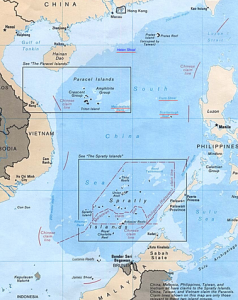Game Theory in International Relations
Territorial disputes in the South China Sea date back to the mid-nineteenth century and continue to involve countries like China, Taiwan, Vietnam, the Philippines, and Malaysia today. The region, notably comprised of small islands and areas of shoreline, was first disputed in the 1870s as surrounding countries made competing claims. After the defeat of Japan in World War II, who administered and occupied the entirety of the region, the disputes have been exacerbated by the discovery of oil and other valuable natural resources. Furthermore, some of the islands are seen as integral to national defense and important in global shipping routes. Although there was hope for settlement in the early to mid 2000s, the reemergence of Chinese, Taiwanese, and Filipino warships following further oil discovery in the region squashed any hopes for possible settlement. The area continues to be a hotbed of potential conflict in South Asia, with the construction of a Chinese airfield creating trouble for President Obama as he prepares to travel to China on September 24th.
(A map of the disputed territorial claims in the South China Sea)
The Potomac Foundation, a Virginia-based think tank and policy institute, recently developed an interactive multiplayer game “Hegemon” to predict potential outcomes in the region from the perspectives of various parties involved. The simulation is based on game theory, using predicted payoffs for each player as a means to map possible outcomes. Potential payoffs for players involved range from economic security to regional hegemony and influence. To achieve these payoffs some of the numerous strategies players can take include cooperation, war, neutrality, and a wide variety of other diplomatic or military options. As discussed in class, an important aspect of determining one’s actions in game theory situations requires knowledge of the other players’ payoffs. What makes the game so interesting is the layer of complexity added by the number of players, including options for the United States and Russia to become involved.
While it is important to keep in mind the theoretical aspect of the simulation, there are some findings from playing the game a repeated number of times which could influence future policy in the region. Only half of the simulations saw an outbreak of war in 20 years, meaning diplomacy and statecraft are possible, even in such a contentious issue. This is especially true for China, which can rely on its presence as a hegemon to pressure countries into bandwagonning with it out of fear or respect. Moscow, Washington D.C., and Hanoi all play unique roles in the conflict based on the simulation due to their geopolitical goals. Finally, in the case of war, conflict would liken the last battleground in the Pacific by placing strategic importance on island chains and involving the possibility of nuclear destruction.
Articles Cited:
http://www.valuewalk.com/2015/08/game-theory-a-new-twist-to-the-south-china-sea/
http://www.cfr.org/world/armed-clash-south-china-sea/p27883

